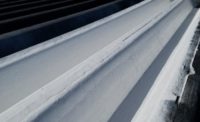
Acrylic
elastomeric roof coatings are liquid-applied, seamless, fully adhered membranes
that are formed in situ on the roof. Some installations are coating-only, while
others combine a variety of fabric designs into the coating matrix, literally
creating a membrane on the roof. (Photo courtesy of Dow Roofing Systems and the
Reflective Roof Coatings Institute.)
Most people have heard the terms acrylic, polymer, elastomeric and reflective. Some terms may seem obvious while others may or may not be understood at all. All polymers are not acrylic, and all acrylics are not appropriate for all applications. In terms of polymers for elastomeric reflective roof coatings, this article will focus only on acrylic polymer technologies.
Acrylic polymers can be designed to be tough and hard, flexible and soft, or at various compositions in-between. Perhaps one the hardest acrylic polymer-based products would be Plexiglas™, an extremely durable polymer composition. Though most forms of Plexiglas are clear, most acrylics are mixed with other materials to create products in thousands of colors for plastics, paints, adhesives, caulks, and other functional coatings.

FIGURE
1 Common Monomers. Note: Tg is an abbreviation for Glass Transition
Temperature. The term is commonly used to describe the “hardness” of an acrylic
polymer.
Acrylic Polymers
The term acrylic often refers to a polymer that is made of two or more acrylic monomers. Figure 1 contains a list of some of the more common monomers used for coatings and paints.The first four monomers whose names end with “acrylate” are acrylic monomers. The last two monomers are not acrylic. It is quite common among polymer suppliers to refer to certain polymers as BA/MMA or some other acronym to describe the basic combination of monomers for that product. Though in a simplistic way it is easy to understand that blending hard monomers (high Tg) with softer monomers (low Tg) can lead to a near infinite combination of monomers resulting in many unique products. Couple this knowledge with additional components and additives used by polymer suppliers which are proprietary and never disclosed, the variety of products that can be produced increases significantly. Figure 2 shows a simple illustration of where many product types fall along the Tg scale.
Tg - an abbreviation for Glass Transition Temperature - is a term commonly used to describe the “hardness” of an acrylic polymer. If the ratio of hard and soft monomers contains mostly the hard monomer, then the Tg of the final polymer will be higher. Conversely, if there is more of the soft monomer than hard monomer, then the Tg will be lower. Figure 3 shows a generic Tg curve. The curve illustrates that if the temperature of the polymer is colder than the reported Tg, then the polymer will be glassy and brittle. If the temperature of the polymer is above the reported Tg, then the polymer will be rubbery and elastic. Products that need to be rubbery and elastic under cold conditions will usually have very low Tg, sometimes as low as -45°C.
The important thing to remember about acrylic polymers is that they can be used for a variety of applications but you need to have the proper acrylic technology for the right job. For example, acrylic polymers used for making floor polish or house paint would both make very poor choices for an elastomeric roof coating.
Acrylic Elastomeric Reflective Roof Coatings
Acrylic polymers have now been specifically designed for roofing applications. Back in the 1980s and even into the 1990s, mistakes were made when house paints were applied on roofs. The results were disastrous because these house paints were much too brittle. Others tried to use caulk and sealant technology to make elastomeric roof coatings, thinking that because they are “soft” they will work. The properties needed for a roof coating far exceed just whether the coating is harder or softer. Expectedly, using caulks or adhesives as a roof coating also met with abysmal failure. Today the technical requirements for a successful roof coating are fully understood and in most cases the proper acrylic polymer is used for the proper end use.Acrylic elastomeric roof coatings are liquid-applied, seamless, fully adhered membranes that are formed in situ on the roof. These coatings are applied 6 to 8 times thicker than house paint. Typically, the thickness of exterior house paint is 3 dry mils, or 0.003 inches. For elastomeric roofing applications, the application rate is typically 18 to 20 dry mils minimum, with higher quality installations being applied at 30 dry mils or more. Some installations are coating-only; while others will combine a variety of fabric designs into the coating matrix, literally creating a membrane on the roof. Competing products known as single-ply membranes are created in a factory, and then applied to a roof. For example, products like PVC, EPDM or TPO are often supplied in sheets 45 mils or thicker. Unlike these single-ply materials, the acrylic roof coating has no seams. Additionally, it is also fully adhered; not requiring mechanical fasteners or adhesives as do single-ply membranes.

FIGURE
2 Products and Tg. Note: Tg is an abbreviation for Glass Transition
Temperature. The term is commonly used to describe the “hardness” of an acrylic
polymer.
Brightness and Reflectivity
Most acrylic elastomeric roof coatings are white or near-white in color. The whiteness of the coating provides two very important features. First it reduces the temperature of the roof surface and more importantly to the membrane to which it is applied. This reduced temperature coupled with the UV blocking properties of the coating reduces the rate of degradation and deterioration of the underlying roofing membrane. Second, the white color reflects as much as 95 percent of the heat portion of the sunlight, reducing the heat transferred into the building and thus reducing the air conditioning costs for that building.For most industrial applications, white acrylic elastomeric roof coatings are the perfect choice because most of these buildings have horizontal, or flat, roofs. The high brightness and reflectivity of the coatings is ideal for reflecting the sun’s energy back into outer space. For residential applications, however, most structures have sloped roofs and the high brightness of the coating would be undesirable. For this reason, residential roof coatings are usually tinted to a medium to deep tone color and are rarely elastomeric technology.
Be Flexible
A roof is not a static structure, meaning that a roof is constantly expanding and contracting with temperature and humidity fluctuations, seismic expansion, the weight of snow and rain loads, wind uplift and even vibrations of the building. The roof coating must also tolerate resistance to foot traffic and even dropping of tools and equipment on the coating. Remember there are many types of equipment that can be located on a roof, including HVAC units, cooling towers, satellite dish antennas; ventilation and cooling ducts, and so on.Flexibility does not just mean being stretchy. Bubble gum is stretchy but quite inappropriate as a roof coating. The point is that other elastomeric type products might be flexible, but totally inappropriate for roofing applications. Caulks, sealants, adhesives, and even elastomeric wall coatings would be completely inappropriate for use as a roof coating. This is because these products are not designed to have the resistance to standing water or impact, and would not be able to retain solar reflectivity properties as needed to maintain cool roof performance.

FIGURE
3 Generic Tg Curve
Durability Requirements
The key property required of any roof coating material is durability. Acrylic technology is widely used in exterior coating applications because of its durability. Durability implies resistance to the effects of ultraviolet radiation (UV) degradation from the sun. Acrylic polymers are transparent to UV which means they do not absorb this most destructive part of the sun’s radiation. The white pigments in an elastomeric coating reflect a majority of the visible and infrared wavelengths of sunlight but they do absorb some of the UV component of sunlight, which is about five percent of that spectrum. Fortunately, the acrylic polymer is not contributing to the absorption of any of the UV radiation. This gives an acrylic elastomeric roof coating a stark advantage over other polymers. For example, asphalt absorbs some of the radiation, and the asphalt begins to vibrate, and break up into smaller pieces. This is the degradation that is associated with the harmful effects of sunlight. This can be seen readily in aged asphalt roofing. Usually within six months, there’s a brown chalky residue on the surface of an asphalt-based coating. This is the result of ultraviolet degradation from the sun.When that same acrylic polymer is formulated into a roof coating and the UV transmission is measured, there is no transmission. This is because the pigments are either reflecting the sun’s energy or absorbing it, effectively protecting the roof substrate beneath.
Reduced Energy Costs
Reflectivity and dirt pickup resistance are key properties for an elastomeric roof coating. Many utilities now offer energy rebates for installations of reflective roof systems. The longer the coating stays white, the longer the reflectivity is maximized. An infrared thermometer is an easy way to measure the surface temperature of a roof. For scientific experiments, sophisticated IR thermometers are used; but for showing simple temperature comparisons between a white and dark roof, any inexpensive IR thermometer is a great way to quickly demonstrate the cooling effects of a white reflective roof coating.Figure 4 shows the surface temperature measured as a function of the time of day of a black roofing shingle versus the same type of shingle coated with a white acrylic elastomeric roof coating. The vertical axis is temperature; the horizontal axis is the time of day. The surface temperature was measured using the infrared thermometer. The maximum air temperature reached during this day was 90°F. The black asphalt shingle reached a maximum temperature of 160°F. This same black asphalt shingle coated with 100 percent acrylic elastomeric coating never reached 100°F. This shows the benefits of reflectivity as the white elastomeric acrylic coating protects the asphalt roofing material and keeps it cooler.
But the story is not over; there is a second benefit here. Consider a warm August afternoon where sudden, quick moving thunder showers are the norm. It’s 3:30 in the afternoon and that black asphalt shingle has a surface temperature of 160°F, then a thunder shower occurs. The temperature of the shingle drops from 160° to 80°F in 15 minutes. The white coating’s temperature drops from 90°F to 80°F in 15 minutes. The black shingle experiences considerably more thermal shock; with an 80°F temperature drop versus a 10°F drop. The black single is undergoing a lot more stress, a lot more strain, more expansion and contraction, as a result of these temperature fluctuations. The thermal stress will shorten the life of a black roof.

FIGURE
4 The Effect of White Roof Mastic on Surface Temperatures
Fire Retardancy
Another benefit of acrylic elastomeric roof coatings is in the area of fire retardancy. Many roofing systems require an Underwriter’s Laboratory class A rating which can be confirmed according to a standard specification UL790. Acrylic Elastomeric Roof Coatings can be formulated with fire retardant pigments to reduce the burning effects on the roofing system. There are three basic ways to stop flame propagation across or into a roof. First, the ERC can contain a component that releases water to quench the flames. One common ingredient proven for decades is Aluminum Trihydrate (ATH). Formulating ATH into an ERC is very easy and cost competitive versus other technologies. Second, additives that release halogens work like a halogen fire extinguisher, releasing components that smother the fire. There are many materials based on halogenated chemistries that can be formulated into an ERC to deliver this performance. Lastly, additives can be used to create a char layer as the coating is burned. These coatings are commonly referred to as intumescent coatings. The char layer is created as the coating burns; the coating literally expands, creating a charred, physical barrier to the flame.Limitations of Acrylic Elastomeric Roof Coatings
There are limitations to an ERC. These coatings can provide some restoration to an aged roof. However, if the roof is too badly deteriorated or the deck is rotted or badly corroded, coating will not return the roof to a useful service life. An ERC is meant to extend the life of a roof, not repair it.Acrylic ERC cannot be applied in the rain or when precipitation is imminent. Acrylic ERCs are applied at rates 10 times thicker than house paint and it will take longer to dry. If the relative humidity is extremely high, say over 90 percent, it will take an extremely long time to dry. New technologies are emerging which give significantly faster resistance to rain after the coating is applied; but acrylic ERCs are waterborne, so application during rain is not possible. No ERC should be applied in the rain or over wet conditions.
Acrylic ERC coatings should not be applied when it is extremely cold. Water freezes, so there are limitations as to the time of year when you can apply the coating. The contractor needs to be conscientious about what the overnight temperature is. It might be warm during the day. But if the evening temperature is going to drop to the mid-20s, there may be a serious problem with freezing of the coating. Further, it is not just the air temperature, but the temperature of the surface to be coated that’s important. Commonly, acrylic ERCs are applied when air temperatures are at a minimum of 50°F and rising.
Another important consideration for the successful application of these elastomeric roof coatings is that the adhesion of the coating is only as good as how mechanically sound the substrate is. An aged roof membrane surface may be dirty or may have a powdery degraded roofing material on it or a new roof membrane may have mica or talc dusting on the surface. These powdery materials prevent the roof coating from achieving acceptable adhesion to the roof membrane substrate. Simply stated, the roof must be properly cleaned, usually with detergent and a pressure washer, to achieve a clean substrate suitable for coating. Just as house paint would not be applied to chipped or peeling surfaces or mold spores, an elastomeric roof coating would not be applied to a substrate that wasn’t mechanically sound and free of debris, dirt, and powdery degraded roof substrate.

Conclusions
• Acrylic coatings provide extended durability. They can be applied over most types of roofing systems and they will dramatically enhance the life of those roofs. They can be applied initially, to a new roof, and they can be applied somewhere later during the life of the existing roof.• They reduce the energy costs. A white acrylic roof coating applied over a smooth surface built-up roof reduces the energy costs, saves money, and also extends the life of that roof.
• Acrylic coatings can lower the roof life-cycle costs by making the roof last longer, and can extend the date that the roof will be replaced.
• From an aesthetic standpoint, these acrylic coatings can be supplied as white for reflectivity, and earth tone colors to compliment the building architecture.


